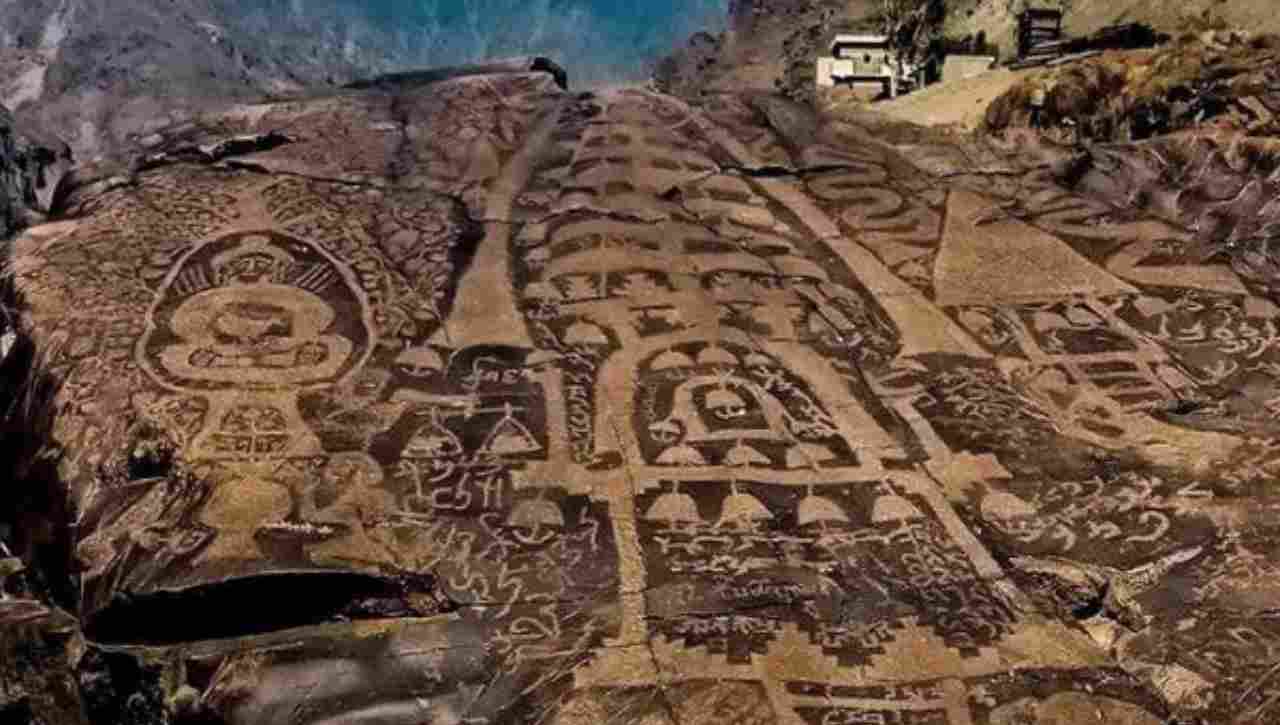The vast rock carvings and inscriptions stretching across 100 kilometers of the Indus Valley, between Shatial and Raikot Bridge, represent an unparalleled archaeological and cultural treasure. This open-air gallery, with its 50,000 carvings and 5,000 inscriptions, offers a unique window into the beliefs, myths, and histories of the diverse cultures that once thrived along this pivotal trade route.
A Monumental Archive in Stone:
The rock carvings and inscriptions along the Indus Valley span an astonishingly long period, revealing a rich tapestry of human expression.
- A Millennia-Long Chronicle:
- The engravings, dating from the 9th century BCE to the 16th century CE, provide a continuous record of human activity over thousands of years.
- This timeline shows how various cultures interacted and left their marks.
- A Cultural Crossroads:
- Located along the Indus and Silk Road trade routes, the site served as a meeting point for diverse cultures.
- The carvings and inscriptions reflect the exchange of ideas, beliefs, and artistic styles among these groups.
- Beyond Traditional Texts:
- The rock art challenges our understanding of how knowledge, faith, and identity were recorded in ancient times.
- It demonstrates the importance of non-textual forms of communication and cultural expression.
A Tapestry of Symbols and Scripts:
The engravings reveal a breathtaking array of symbols, deities, and scripts, offering insights into the beliefs and practices of the people who created them.
- Religious and Mythological Imagery:
- The carvings depict various deities, religious symbols, and mythological scenes, reflecting the spiritual beliefs of the region.
- They offer clues about the rituals, ceremonies, and cosmological views of these ancient cultures.
- Multiple Scripts:
- Inscriptions in multiple scripts, including Brahmi, Kharosthi, and Sogdian, highlight the diverse linguistic influences along the trade routes.
- These scripts provide valuable information about the languages spoken and written in the region.
- Pilgrims and Traders:
- The engravings also depict scenes of pilgrims, traders, and other travelers, reflecting the site’s role as a major thoroughfare.
- These images offer insights into the daily lives and activities of the people who traversed these routes.
A Threatened Legacy:
The rock carvings and inscriptions face numerous threats, raising concerns about their long-term preservation.
- Time and Erosion:
- The natural elements, including wind, rain, and temperature fluctuations, are gradually eroding the rock surfaces.
- This poses a significant threat to the preservation of the intricate carvings and inscriptions.
- Development and Vandalism:
- Modern development projects, such as road construction and mining, pose a threat to the site’s integrity.
- Vandalism and looting also contribute to the damage and loss of these invaluable cultural artifacts.
- The Need for Protection:
- The question of whether more should be done to protect the site is a critical one.
- The site’s immense cultural and historical significance warrants greater efforts to ensure its preservation for future generations.

The Importance of Preservation:
The rock art of the Indus Valley is a priceless cultural heritage that deserves our attention and protection.
- A Window into the Past:
- The site offers a unique opportunity to understand the beliefs, practices, and daily lives of ancient cultures.
- It serves as a tangible link to our shared human history.
- Educational and Research Value:
- The carvings and inscriptions provide valuable data for researchers in various fields, including archaeology, linguistics, and art history.
- They offer insights into the development of human communication and cultural expression.
- Cultural Identity:
- The site holds deep cultural significance for the local communities and the nations through which the Indus river flows.
- It represents a vital part of their heritage and identity.
The rock art of the Indus Valley is a monumental archive of human history, inviting us to contemplate the lives and beliefs of those who came before us. It is imperative that we take steps to protect this invaluable cultural treasure, ensuring that its stories continue to resonate for generations to come.

CÁC TIN KHÁC
Mary Walton: The Forgotten Inventor Who Helped Clean Up America’s Cities
Tomb of Queen Nefertari in the Valley of the Queens, Egypt
Discover the Hypostyle Hall of the Temple of Hathor at Dendera
Venus de Losange: Unveiling the Mystery of a 20,000-Year-Old Paleolithic Icon